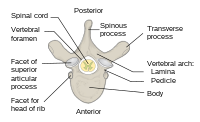
Photo from wikipedia
BackgroundThe prevalence of cervical block vertebrae is unknown. Furthermore, there is no consensus on the cause of adjacent segment degeneration (ASD) after cervical fusion.Questions/purposes(1) What is the incidence of cervical… Click to show full abstract
BackgroundThe prevalence of cervical block vertebrae is unknown. Furthermore, there is no consensus on the cause of adjacent segment degeneration (ASD) after cervical fusion.Questions/purposes(1) What is the incidence of cervical block vertebrae? Is there a gender difference? (2) Among cervical block vertebrae cases, is ASD related to age and segment? And what is the specific relationship? (3) What are the imaging findings and characteristics of this disease?Patients and methodsWe retrospectively diagnosed cervical block vertebrae cases with bony fusions in any segments of the cervical spine without intervertebral fusion surgery of 33,762 patients reported from 2006 to 2011 in north China. Then the X-ray of the obtained cases were observed and counted. The primary outcome was incidence of ASD according to age and segment. The secondary outcome measures were C2–7 angle in fusion (single segment fusion of lower cervical vertebra) and control groups (randomly selected cases of non-fusion), Cobb’s angle of fusion segments, and curvature of each lower cervical segment in the control group.ResultsA total of 218 cervical block vertebrae cases were found, with a incidence of 0.65%, and C2–3 represented the highest number of fusion segment cases. There were no significant differences in the incidence by sex. Varying degrees of degeneration in the adjacent segment was present in 112 cases (51.4%). The incidence of ASD increased with age, with the ASD growth rate reaching its peak at the age of 51–60 years (55.08%). Cervical curvature shows no significant difference between patients with cervical block vertebrae and normal individuals. The segmental curvature was lower in the fusion group than in the control group, with statistical significance achieved in fusion segments located in C4–5, C5–6, and C6–7, but not C3–4.ConclusionsFusion segments located in C4–5, C5–6, and C6–7 are more prone to ASD than C3–4. The incidence of ASD in patients with vertebral fusion increases with age.Level of evidenceIII.
Journal Title: European Spine Journal
Year Published: 2017
Link to full text (if available)
Share on Social Media: Sign Up to like & get
recommendations!